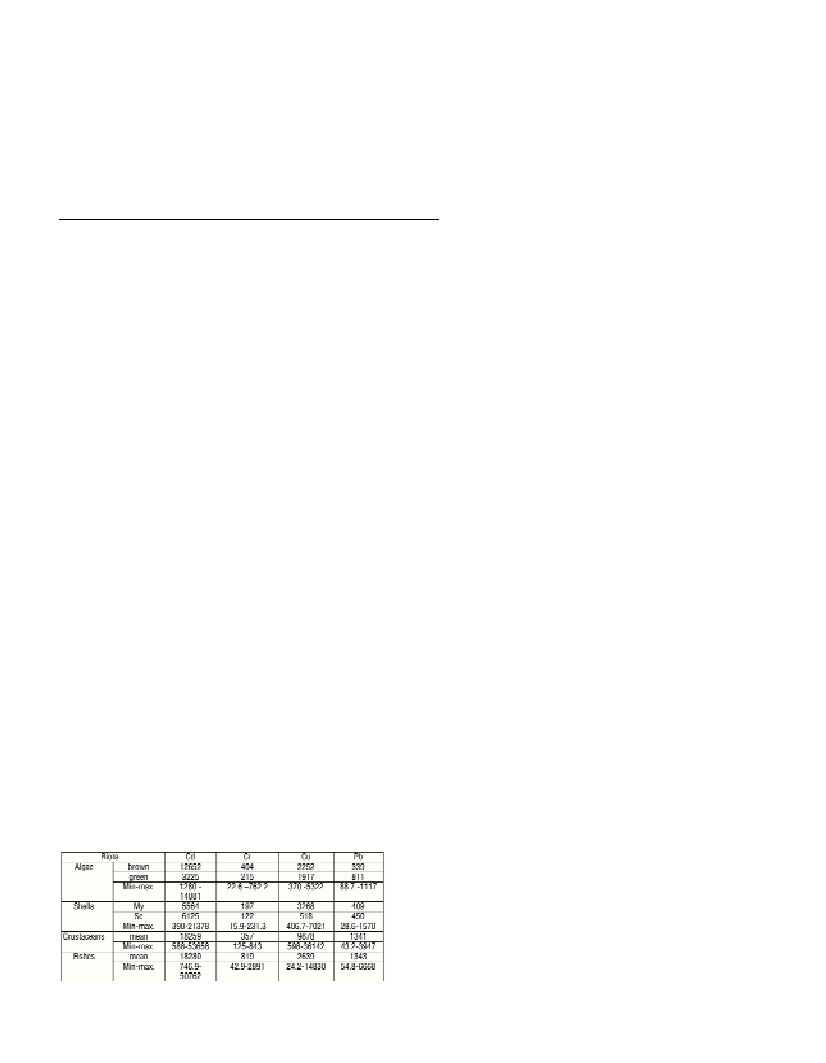ABOUT ACCUMULATION FACTORS OF CD, CR, CU AND PB IN THE BLACK SEA COAST BIOTA
Elisabeta Chirila
1
*, Adrian Bavaru
2
, Ionela Carazeanu
1
1
Department of Chemistry, University “Ovidius” of Constantza, 124, Mamaia Blvd., 900527, Constantza, Romania,
* echirila@univ-ovidius.ro
2
Department of Biology, University “Ovidius” of Constantza, 124 Mamaia Blvd., 900527, Constantza, Romania
Abstract
This paper deals to report original results concerning four metal accumulation factors in the Romanian Black Seacoast biota. Cd, Cr, Cu
and Pb were determined in brown and green algae, mussels, crustaceans, fishes and also in water using ?ame atomic absorption
spectrometry.
Keywords: trace metals, Black seacoast biota, FAAS, concentration factors.
Rapp. Comm. int. Mer Médit., 37,2004
179
Introduction
The release of heavy metals into our environment is still large. In
certain areas of the world it is even increasing. Cadmium, chromium,
copper and lead play an important role in marine ecosystems as
pollutants or essential elements. Their study has increased in the last
decades, but biogeochemical cycles may be better explained in active
areas. Bioaccumulation (defined as association of a metal with an
organism) is a necessary first step before organisms can manifest a
response to metals or in?uence metal geochemical cycling. Many
studies published in recent years evaluate the rates and mechanisms of
metal bioaccumulation in marine organisms (1-4).
This investigation was carried out in the Black Seacoast ecosystem.
Original results of Cd, Cr, Cu and Pb accumulation in marine biota are
reported.
Experimental
Samples were collected during the summer of 2002 from eight
stations placed on the Romanian Black Seacoast between Midia and
Vama Veche. Algae (Ceramium sp., Cladophora sp., Enteromorpha
sp., Polysiphonia sp., Ulva rigida), mussels (Mytilus sp., Scapharca
sp.), crustaceans (Crangon crangon, Gammarus sp., Idotea sp.,
Palaemon sp., Pontogammarus sp., Sphaeroma sp.) and fishes
(Apollonia melanostomus, Atherina sp., Blennius sanguinolentus,
Mugil auratus, Ponticola cephalargoides) samples were carefully
washed with deionised water, hashed and dried. 0.1 – 0.9 grams of
each dry sample was submitted to digestion with nitric acid and
hydrogen peroxide at 170
0
C in a Digesdahl device provided by Hach
Company [5, 6]. For the determination of metal concentration an AA
6300 ?ame atomic absorption spectrometer provided by Shimadzu
Company was used.
Results and discussion
The goal of this work was to study the accumulation of cadmium,
chromium, copper and lead in the Romanian Black Seacoast biota.
Aquatic organisms may take up trace metals mainly from solution
and from food. For example mussels, as filter feeders effectively filter
particulate matter out of suspension and therefore this suspended
matter may be a source of trace metals. Gagnon and Fischer
demonstrate that the organic content of suspended particles may
in?uence bioavailability of trace metals (7).
The concentration factor was calculated as the rapport between
ppm metal in organism and ppm metal in water (8).
The table 1 summarizes the obtained results. There are presented
mean values of concentration factors for brown and green algae, for
two shells species (Mytilus sp. –My and Scapharca sp.- Sc.), for
crustaceans and fishes. In the same time in the table are presented the
interval of concentration factor’s values for each category.
Table 1. Concentration factors of Cd, Cr, Cu and Pb in the Romanian
Black Seacoast biota.
It can be observed that brown algae have higher metal accumulation
capacity than the green ones, excepting lead.
There is a large variation of concentration factors in each biota
category. That may depend on the sample’s collecting points, on the
species but also on the physiologic behavior of organism.
Cadmium has the highest concentration factors in all biota species
from Romanian Black seacoast.
As a conclusion, for all studied biota categories the concentration
factors of trace metals increase as follows: Cr<Pb<Cu<Cd.
References
1-Fisher N.S., Stupakoff I., Sanudo-Wilhelmy S.A., Wang W.-X., Teyssié
J.-L., Fowler S.W., and Crusius J., 2000. Trace metals in marine copepods:
a field test of a bioaccumulation model coupled to laboratory uptake
kinetic data. Mar. Ecol. Prog. Ser., 194: 211-218.
2-Wang W.-X., and Fisher N.S., 1999a. Assimilation efficiencies of
chemical contaminants in aquatic invertebrates: a synthesis. Environ.
Toxicol. Chem., 18: 2034-2045.
3-Griscom S.B., Fisher N.S., and Luoma S.N. 2002. Kinetic modeling of
Ag, Cd and Co bioaccumulation in the clam Macoma balthica;
quantifying dietary and dissolved sources. Mar. Ecol. Prog. Ser., 240: 127-
141.
4-Baines S.B., Fisher N.S., and Stewart R., 2002. Assimilation and
retention of selenium and other trace elements from crustacean food by
juvenile striped bass (Morone saxatilis).Limnol. Oceanogr., 47: 646-655.
5-Chirila E., Carazeanu I., Bavaru A. and Belc M.,2003. Cadmium
occurrence in the Black Sea ecosystem. Proc. Int. Conf. Bramat 03,
Brasov Romania, 4: 354-357.
6-Chirila E., S. Birghila and P. Capota, 1999. Biogeochemical
characterisation of an ecosystem using ICP-AES’. S. Afr. J. Chem,.52:
154-156.
7-Gagnon C. and N.S. Fisher, 1997. The bioavailability of sediment-
bound Cd, Co and Ag to the mussel Mytilus galloprovincialis. Can. J.
Fish. Aquat. Sci., 54: 147-156.
8- Bowen H.J.M, 1966. Trace elements in Biochemistry. Academic Press,
New York and London.

